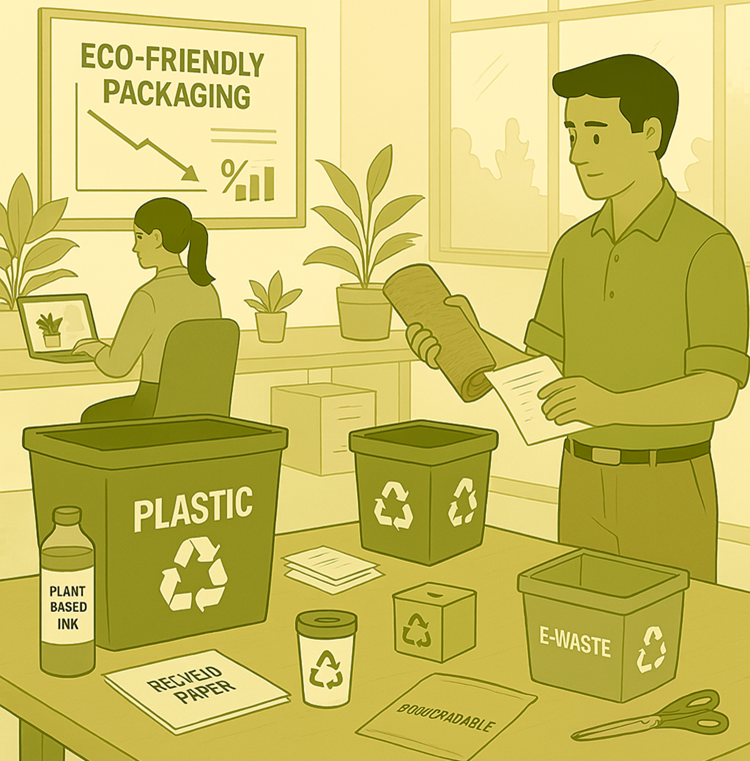Practical Ways to Minimize Waste in Business Processes
- KPM SMARTBiz

- Jul 2
- 4 min read
Updated: Jul 3
These days, cutting down on waste isn’t just about being eco-friendly—it’s also a smart move for your business. When you find ways to waste less, you're not just helping the planet, you're saving money and boosting your brand's reputation too. In this post, we’ll look at some simple but effective ways to reduce waste in your business and make a real impact.
Understanding Waste Reduction in Business
Waste reduction involves implementing strategies to minimize the amount of waste produced in business operations. This can include everything from reducing physical waste like paper and plastic to optimizing digital processes to minimize data storage.
The current statistics highlight the importance of waste reduction. According to the World Bank, global waste generation is expected to increase by 70% by 2050 unless we take immediate action. This trend is alarming and indicates that businesses must shift their focus towards waste management and reduction to create a sustainable future.
Identifying Key Areas for Waste Reduction
To effectively reduce waste, businesses must first identify the areas where they generate the most waste. Common areas include:
Office Supplies: Paper, printer cartridges, and plastic items can accumulate quickly.
Energy Consumption: Inefficient machinery and poor energy practices can lead to wasted resources.
Packaging Material: Excessive packaging can lead to significant waste output.
Inventory Management: Overproduction or poor inventory can lead to food or product waste.
Conducting a waste audit can help pinpoint specific areas where waste is generated and how it can be minimized.
Adopting Recycling Programs and Sustainable Practices
One of the simplest methods for waste reduction is implementing comprehensive recycling programs. By setting up designated recycling bins in all areas, employees can easily dispose of materials correctly. Additionally, businesses should partner with local recycling centers to ensure that items like plastics and metals are properly recycled.
Moreover, businesses can adopt more sustainable practices, such as using refillable containers for office supplies and encouraging employees to use both sides of paper. According to the EPA, recycling one ton of paper can save 17 trees, which underscores the impact that small changes can make.
Companies can also consider adopting a "zero-waste" approach where continuous improvement in resource efficiency is the goal. This commitment can not only reduce waste but can also enhance employee morale and public image.
Implementing Digital Solutions for Waste Reduction
In the digital age, businesses must leverage technology to minimize waste. Here are practical steps for digitization:
Paperless Office: Transitioning to a paperless office can drastically reduce paper waste. Use digital signatures and online document sharing to minimize the need for physical documentation.
Cloud Storage: Using cloud storage can minimize the need for physical storage, reducing the carbon footprint associated with maintaining large data centers.
Efficient Communication Tools: Adopting tools like instant messaging or project management software can reduce unnecessary emails and meetings, enhancing efficiency and reducing not just digital waste but also time waste.
The shift to digital platforms can lower operational costs and reduce the environmental impact of business processes simultaneously.
Training Employees on Waste Reduction Techniques
It is essential to involve employees in waste reduction efforts. Training sessions can help raise awareness regarding the importance of reducing waste and can teach staff about specific practices they can adopt in their daily routines.
For example, educating employees on proper recycling procedures, the impacts of excessive printing, and energy-saving practices can foster a corporate culture focused on sustainability. When employees understand the significance and benefits of waste reduction, they are more likely to contribute actively to those efforts.
Monitoring Progress and Continual Improvement
After implementing waste reduction strategies, businesses must regularly monitor their progress. Collecting data on waste production will enable companies to assess whether their strategies are effective and where adjustments may be necessary.
Key performance indicators (KPIs) can include:
Reduction in the volume of waste generated
Increased recycling rates
Cost savings associated with reduced waste management
Setting measurable goals not only provides motivation but also creates accountability within the organization. Continual improvement is key to a successful waste reduction strategy.
By adopting these practices, companies can achieve a substantial reduction in waste and contribute to a more sustainable environment. For more information on waste reduction techniques, consider exploring professional services that specialize in waste minimization.
Fostering a Sustainable Brand Image
In an increasingly eco-conscious market, fostering a sustainable brand image through waste reduction is not just a long-term strategy; it is an essential approach for competitiveness. Companies that prioritize sustainability attract consumers who want to support businesses that align with their values.
Emphasizing waste reduction commitments in marketing materials and on social media can differentiate a business from its competitors. Showcasing successful recycling initiatives, sustainable product sourcing, and energy efficiency efforts can position a brand as a leader in responsible business practices.
As the world continues to grapple with waste management issues, those businesses that take decisive action towards waste reduction will not only enhance their operational efficiency but also establish a reputation for being responsible corporate citizens.

By taking these practical steps, businesses can minimize waste effectively while promoting sustainability in their operations. Committing to waste reduction can yield tremendous benefits that extend beyond the company, positively impacting the environment and society at large. It’s time to act decisively and make waste reduction a priority in your business processes.
Learning to work SMARTer, not harder!







תגובות